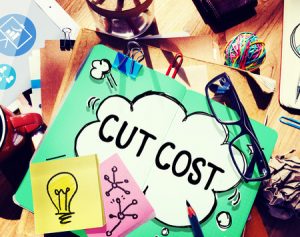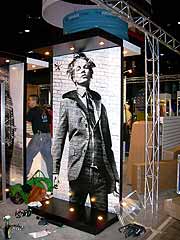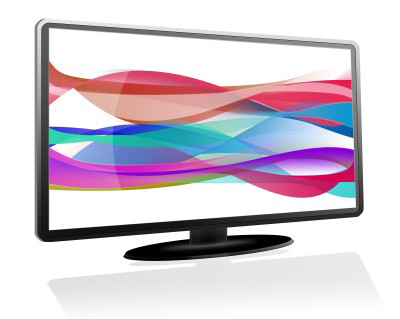Trade Show Strategies: 5 Ways to Cut Cost and Make a Big Impression
It’s just smart business to look for ways to get more from your trade show budget.  Since your competitors are probably getting creative with their budget too, it’s the perfect time to take advantage of the situation with some out of the box thinking.
Since your competitors are probably getting creative with their budget too, it’s the perfect time to take advantage of the situation with some out of the box thinking.
There are lots of ways to save money on your trade show budget – from managing travel and entertainment expenses to strategies for consolidating shipments to the show – but I’ll leave all of that to you. My focus is on ways to save money on your trade show booth without giving up any marketing impact. Here are a few tips on how your trade show booth can be high-impact for less money.
- Reduce transportation costs with a new lower-weight booth
Trade show design has really changed in recent years. High energy and transportation costs pushed design houses to rethink their approaches. New booths are constructed from light-weight, high strength materials, are less expensive to ship and also have a sleeker, more contemporary look. - Design for easy assembly
As designers began to work with new materials and modular components, hard-to-assemble booths built with rigid infill panels and wooden construction have gone the way of the dinosaur. Find a design firm with a proven track record of creating booths that have big graphic impact but do not require a cast of thousands to set up. - Rent – don’t buy
Many large trade show design firms rent trade show components and booths. If your company only has one or two trade show events each year, or you need to get a larger booth just for one annual trade show, renting can be a great option. - Buy a Used Trade Show Booth and Accessories
Some companies trade in or sell off trade show displays frequently in order to update their display to match their latest ad campaign. A smart buyer can pick up a like-new display for a fraction of the original price. If you take this route, be sure to buy from a provider who refurbishes and customizes displays. - Update your current Trade Show Display
If your company already has trade show booths, take an objective look to see if they can be updated to fit your current needs for an affordable price. Be careful about investing in an outdated booth that is very costly to transport, assemble and operate because it can represent a false savings. However, sometimes the most cost-effective path is to update graphics, fabric and add new components to an existing booth.
If you’re ready to save money on your trade show budget, Let’s Talk.
What To Do With An Old Trade Show Exhibit
What is the Value Of A Used Trade Show Display?
There are many reasons why a company might decide that they no longer want or need their current trade show booth. Perhaps budgets have been slashed, requiring reduced space and a too large, too heavy and too expensive to set up exhibit will no longer meet needs. Or conversely, it could be a result of growth that requires a step up in size and/or capability. Has the exhibit become outdated? No longer fits the company’s image? If you’ve considered updating the existing booth with new graphics or supplementing with rental components, and that just isn’t an option, then what?
 Before considering your disposal options, you must first consider the fact that the tradeshow display probably appears as an asset on the company’s books. So, if disposed of, it will result in a loss on financial statements. Add to this the fact that the display consists of some hazardous materials, so disposal costs will be significant and you can see why disposal is not likely to be a popular move in the eyes of the bean counters.
Before considering your disposal options, you must first consider the fact that the tradeshow display probably appears as an asset on the company’s books. So, if disposed of, it will result in a loss on financial statements. Add to this the fact that the display consists of some hazardous materials, so disposal costs will be significant and you can see why disposal is not likely to be a popular move in the eyes of the bean counters.
Also, be realistic about the value of a used tradeshow display. Companies generally want to design a new booth to their own specifications. Even if your display closely matches their needs, the cost of refurbishment, changing finishes and colors and producing new graphics can quickly add dramatically to the cost. It is not unusual for tradeshow booths that originally cost hundreds of thousands of dollars to be nearly worthless in the used market.
Options For Your Old Trade Show Booth
So… what are your options?
- Bite the bullet. Get a quote from your display company, pay the handling and disposal fees, write off the loss, and move on. (This is a major reason many companies choose to only rent their displays).
- Try to sell your old tradeshow booth. Gather as much information about the display as possible. Photos, drawings and inventory lists are critical to success. Post the display on a used exhibit web site (www.exhibitrader.com for example). Ebay and Craigslist might work to sell portable exhibits, but larger displays probably won’t get much attention. Be realistic about an asking price.
- Make a deal with your exhibit company. Roll the old booth into the purchase or rental of a new display. Showing a “trade-in allowance” on the contract will be much easier on the financial statements and also eliminate your disposal liability.
- Donate your booth. Try to find a charity that might have some use for all or part of the display. Admittedly, this is a long shot, but is worth checking into.
No matter which direction you take, it is always a shame that something so exciting and valuable when it was originally built ends up such a pain to get rid of.
Signage at Tradeshows: How Big is Too Big?
All companies that exhibit at tradeshows want their name to be the most prominent in the convention center. At large shows with hundreds of exhibits this is obviously not possible. When you walk into the exhibit hall, you are confronted with sea of visual clutter. So what is the correct approach to signage in your booth?
Consider this:
Exhibit signage breaks down into 3 basic categories, long, medium and short range graphics. Each of these categories serves a practical purpose.
Long Range Graphics
 These are most often corporate identification graphics. In island or peninsula displays, they can be large signs that are placed at the maximum height allowed by the show. They are sometimes suspended from the convention center ceiling (where permitted) or can be supported from the floor on tall columns. The purpose of long range graphics is to allow visitors to locate your exhibit from the entrance of the hall or at least from several aisles away. Most companies want these signs to be as large as possible, so they can’t be too big. When every exhibit has these large signs, they lose their effectiveness. Sometimes adding lighting or rotating the signs will add interest. These types of signs are generally not permitted in backwall displays.
These are most often corporate identification graphics. In island or peninsula displays, they can be large signs that are placed at the maximum height allowed by the show. They are sometimes suspended from the convention center ceiling (where permitted) or can be supported from the floor on tall columns. The purpose of long range graphics is to allow visitors to locate your exhibit from the entrance of the hall or at least from several aisles away. Most companies want these signs to be as large as possible, so they can’t be too big. When every exhibit has these large signs, they lose their effectiveness. Sometimes adding lighting or rotating the signs will add interest. These types of signs are generally not permitted in backwall displays.
Medium Range Graphics
As visitors get closer to your exhibit, it is important to show them who you are and what you do. At 20 feet away from an island booth, the visitor would need to look straight up to read your large overhead sign, so medium range graphics should include your corporate identification. Individual product names and informative tag lines are appropriate at this level. In smaller displays, medium range graphics are the only corporate identification and should clearly state who you are and what you do. Medium range graphics should be large enough to be read from a reasonable distance but not too large to interfere with the exhibit design. They should be positioned at or just above eye level.
Short Range Graphics
Signs of this nature include any graphic that can only be read while standing in or very near the display. They usually include product or brand identification signs and can include more detailed information since you are conveying information to interested attendees, not trying to lure them to your display. Features, benefits, specifications and installation examples are perfect for short range graphics. These signs do not need to be very large and should be placed just below eye level for ease of view.
While these are very basic guidelines, they will result in well-designed, effective and cost effective exhibits.
Need a unique and effective tradeshow booth idea? We can help you create a custom trade show exhibit that creates a buzz about your brand and increases your booth traffic, all within your budget. Let’s Talk.
How Tradeshows and Social Media Co-exist
There is Still a Place for Trade Shows in Your Marketing Mix
Talk to anyone who sends more than 2 texts a day and they will tell you that the only way to market products and services is to use Twitter, Facebook, Linkedin or search engine optimization. They consider face-to-face marketing to be an antiquated form of communication and that the days of tradeshows are numbered.
 Those of us who make our living producing trade shows get the opportunity to see things in a different light. Walk the aisles at the consumer electronics show and watch buyers from all over the world making deals with major manufacturers. Go to the HIMSS show and see hospital administrators finalizing plans for purchase of their new IT infrastructure. Attend the American College of Cardiology meeting and listen to heart specialists discussing the advantages of various new instruments with the inventor. This type of important business communication can only be done face-to-face and the most cost- and time-effective way to do this is at a tradeshow.
Those of us who make our living producing trade shows get the opportunity to see things in a different light. Walk the aisles at the consumer electronics show and watch buyers from all over the world making deals with major manufacturers. Go to the HIMSS show and see hospital administrators finalizing plans for purchase of their new IT infrastructure. Attend the American College of Cardiology meeting and listen to heart specialists discussing the advantages of various new instruments with the inventor. This type of important business communication can only be done face-to-face and the most cost- and time-effective way to do this is at a tradeshow.
Social Media Should be an Important Part of Your Tradeshow Promotion
The fact is, social media can and should be an important part of tradeshow promotion and communication. The ability to reach out to potential customers before, during, and after a show using this technology can greatly increase tradeshow ROI. Just like any other marketing project, exhibitors should enlist the assistance of a person or group that has experience with the most popular networks, explain their goals and put together a plan for your tradeshow.
Keep an open mind. Don’t expect overnight success. Continue to review and improve your approach to both media and the results will come. Let’s talk.
Chasing Tradeshow Cost Savings?
Many exhibitors are being forced to find ways to reduce the cost of participation in tradeshows. The most common way this task is approached is to look at each cost line item and see what can be done to save money.

The common first step is to contract for a smaller booth space. This not only saves on the cost of the space rental but also provides an across-the-board cost reduction. The downside of such a reduction? You may have to settle for a less than desirable booth location and you’ll also need to make sure your display properties will fit in the smaller format.
After booth space, the likely second step is to look at each cost category for the show and try to determine which costs can be reduced. This is a very time-consuming process, and usually entails trying to find out how much your exhibit weighs and how long it should take to set up. This information is not always easy to get your hands on, and when you do, there are always a slew of variables that can affect the final cost of the show.
In my opinion, however, the best first step to take is to contact your exhibit supplier (assuming they store and manage your display) and lay your cards on the table. Explain to them that you have been asked to cut 25% off the cost of last year’s show. Ask them to provide recommendations. Remember, they do this for a living! They are not likely to be overly excited about this mission, but they should support you through good times and bad.
If they can’t or won’t provide you with some good ideas, you should probably consider finding another supplier.
Thinking about changing exhibit companies? Let’s Talk.
Exhibit Acronyms – What is a Trade Show RFP?
RFP is an Acronym for Request for Proposal
 This is one of the few tradeshow exhibit industry terms that is also pretty common in other areas of business. In a nutshell, it means that your company has a need to buy products or services and you’d like to invite prospective vendors to submit proposals. RFPs can be sent out for something as simple as a rental backwall display or as elaborate as complete multi-year management of a hundred shows per year tradeshow program.
This is one of the few tradeshow exhibit industry terms that is also pretty common in other areas of business. In a nutshell, it means that your company has a need to buy products or services and you’d like to invite prospective vendors to submit proposals. RFPs can be sent out for something as simple as a rental backwall display or as elaborate as complete multi-year management of a hundred shows per year tradeshow program.
Once received, evaluation of submitted proposals can be difficult and time-consuming. As such, the number of companies that you invite should be limited to 3 – 5.
The basic RFP format is to provide:
- An overview of your company.
- A summary of your needs.
- An outline of how and when proposals should be submitted.
In order to make the process as efficient as possible, it is best to provide information that is concise. The key to dealing with responses in a timely fashion is to direct submissions so they are as similar in format as possible.
If you intend to request custom exhibit designs from bidders, keep in mind that designs are presented in a variety of formats from renderings mounted on boards to web-based video productions. You should clearly communicate the presentation format you prefer. When requesting designs, providing a budget number will make the final evaluation process much more productive.
You should also provide a format for the cost portion of the proposals. This can be in the form of a spreadsheet included in your RFP to be filled out and returned, or even as simple as an itemized list. Including this information helps to clearly describe what cost elements are to be included in the proposal. Things like carpet, electrical service, vacuuming, floral or technical support are not always part of the RFP process.
The bottom line? Give prospective vendors enough information to put together a proposal that is complete and in a format that makes it easy to compare. Time spent editing and refining your RFP documents can result not only in significant time savings when the time comes to review submissions, but also more quality in responses.
Need Exhibit Management for your trade show? We are ready to earn your business. Let’s talk.
Ten Tips for Better Trade Show Exhibits
Trade shows can be one of the most cost-effective ways for your company to reach qualified prospects. And with a little bit of planning you can dramatically improve your results.
 Start planning as soon as you know you will be attending the show. Make your booth space reservation as far in advance as possible so you can select the best location and size.
Start planning as soon as you know you will be attending the show. Make your booth space reservation as far in advance as possible so you can select the best location and size.- The majority of trade show attendees plan their trade show exhibit visits before the show. 75% of buyers arrive with pre-set purchasing objectives. A pre-show marketing campaign is essential to making the most of your trade show exhibit investment.
- Most trade shows are covered by local and industry media. Before the show, invite local media contacts to visit your booth. Find out if there will be any trade press at the show and set up a time to meet.
- Promote the shows your company will be exhibiting at and your booth location on your company website, Twitter and Facebook pages.
- Avoid printing anything at the trade show or at a hotel business center. Ship copies from your office or a printer to the show.
- Put together a comprehensive inventory list before you ship your exhibit. This will make check in and out-bound shipping more efficient, and better ensure that any missing items are identified rapidly.
- Bring more sales collateral and business cards than you think you could possibly need. You cannot afford to run out and it is inexpensive to ship it back to your office.
- Bring backup copies of all multimedia presentations on CDs just in case you have an issue with your laptop. You can also store copies of presentations online so that you can access them and download if needed.
- Organize your trade show leads in the downtime during the show and start to follow-up even before you leave the exhibit floor. Send the contact information for prospects to your office from the show and have someone send out requested collateral material to these prospects so it is waiting for them when they return to their office.
- Put together a trade show exhibit emergency kit: packing tape, scissors, pens, epoxy putty, a small trash can, power strips, extension cords, USB flash drives, cutting tools, and a tool kit. Add in anything that you might need for small emergency booth repairs and replacement parts for anything that can wear out or burn out like light bulbs.
Trade show exhibits are a big investment. Just a little bit of planning and a few tips from the pros, and you are well on the way to having a less stressful and more successful trade show exhibit.
Why You Should Replace Traditional Graphics With Flat Screen Displays
Situation: You are getting ready to exhibit at your most important show of the year. You pull your exhibit out of the warehouse and realize that the graphics and entire exhibit looks outdated and tired. You need to update, but your budget is limited. You can’t afford to replace your entire trade show booth – you can’t afford to fade into the background at this show.

One Solution: Replace your exhibit graphics with flat screen display monitors and a media player.
There are many ways to update and refresh an outdated trade show exhibit. Increase booth impact by replacing graphics with digital displays will add a high-impact look to your display and help bring it up to speed with newer, more high-tech exhibit properties.
Converting your graphics to flat screen digital displays can involve greater up-front costs than just replacing the graphic panels, but you will be building longevity and flexibility into your exhibit. Plus, adding digital display monitors has other benefits:
- You may be able to save on graphics production unless you create very elaborate digital presentations.
- You can create attractive dynamic signage that will attract attention and draw more people into your booth.
- You can quickly update your messaging by creating new content.
- You can affordably adjust your brand presentation and featured products for each show’s specific market.
- You can create presentations that will help customers visualize what you can do for them.
Updating your trade show booth with digital display monitors and a dynamic presentation can help you attract trade show attendees and encourage more of them to buy your products or services.
Need help with updating your trade show display? We can help. Let’s talk.
Trade Show Planning Tips – Develop a Timeline
Doing Basic Planning Makes Participation in a Trade Show More Profitable and Less Stressful.
 First ask yourself, what do you want from the show?
First ask yourself, what do you want from the show?
As you begin your planning process, be sure to understand why your company is spending the money to rent a space in the first place. Who will be attending? Which attendees are important to your company and why? What products do you have to show? What do you want to say to visitors to your booth? Gaining a clear understanding of these “strategic” goals is vital to helping everything else fall neatly into place. As such, decisions on design, graphics, product placement, staffing, etc. should all be made based on your overall show strategy.
Next, develop a timeline.
Most show manuals include a timeline or schedule of events. This is helpful for dealing with the logistical details, but you need to make a personal timeline to guide your planning. You will also need to deal with your tradeshow display, all graphics, literature and premiums, room and dinner reservations, the list goes on and on. The only way to keep all of this organized and still be able to sleep at night is to start with a timeline. The first one that you make will be very difficult and time-consuming, but with the groundwork laid, subsequent show timelines can be as easy as cut and paste.
Get some help.
Your exhibit company should be able to take most of the display issues off of your shoulders, but it is best to confirm things with them from time to time to make sure that they are on track. This will allow you to focus on the things that are more difficult to outsource.
Be sure to set internal deadlines.
Make sure that things that must be done internally are listed on your timeline and communicate deadlines well in advance to everyone involved. Often, one of the most difficult things for trade show managers to do is to get their own trade show booth shipped to the show on time. With that in mind, sometimes it makes sense to set an internal deadline that leaves you a week or so fudge factor just in case.
Brochures need to be ready to go well in advance. It may make sense to send your boxes of literature to your exhibit company so that they can ship them to the show with the display. This will allow you to check one more thing off of your list, and as an added benefit, it’s one less shipment you’ll have to track down on-site.
Develop a trade show timeline, check it several times a day, and work well in advance. It’s not as easy as it might seem, but the payoff is well worth the effort.
Need trade show advice? Let’s talk.
Archives
- July 2021
- June 2021
- May 2021
- April 2021
- October 2018
- September 2018
- August 2018
- July 2018
- June 2018
- May 2018
- April 2018
- March 2018
- February 2018
- January 2018
- December 2017
- November 2017
- October 2017
- September 2017
- August 2017
- July 2017
- June 2017
- May 2017
- April 2017
- March 2017
- February 2017
- January 2017
- December 2016
- November 2016
- October 2016
- September 2016
- August 2016
- July 2016
- June 2016
- May 2016
- April 2016
- March 2016

 A while back, I had the opportunity to deliver a demonstration display to a prospective client who was considering the purchase of several units. The only way that I could transport the cases for this 10’ display was to strap one of them to the top of my midsized SUV! Needless to say, the client questioned the portability of that particular unit. Fortunately, every other display that met her needs packed in multiple cases with wheels and weighed about the same so we had many better options, but sometimes lessons are learned from bad as well as good.
A while back, I had the opportunity to deliver a demonstration display to a prospective client who was considering the purchase of several units. The only way that I could transport the cases for this 10’ display was to strap one of them to the top of my midsized SUV! Needless to say, the client questioned the portability of that particular unit. Fortunately, every other display that met her needs packed in multiple cases with wheels and weighed about the same so we had many better options, but sometimes lessons are learned from bad as well as good.